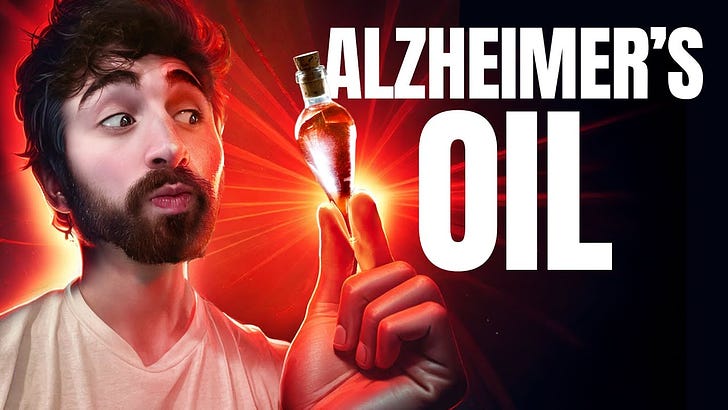This Nutrient May Protect Against Alzheimer's
New research in Cell Metabolism reveals a mechanism whereby LPC can protect against Alzheimer's disease. I'll explain why this is important...
I just had the pleasure of joining Louisa Nicola for part 1 of a nuanced conversation her podcast, The Neuro Experience, about Metabolic Health. One of her interests is cognitive health and cognitive longevity, and we touched upon new research on Alzheimer’s prevention based on brand new data in Cell Metabolism. But we didn’t get to dive in deep enough…
In her honor, and as a teaser for a YouTube video to drop in the future, I want to break down these new data. Let’s go…
New Paper on Alzheimer’s Disease
This paper is now covered in a YouTube Video on my channel, which you can check out here by clicking below. Or, if you prefer to read… read on!
This new paper has me giddy with excitement since it provides a potential accessible and actionable tool in my Alzheimer’s prevention arsenal – one I want to share with you.
First for some high-level background, it’s well established that there is a strong link between gut and brain. Specifically, microbes in your gut make specific “mysterious” metabolites that influence brain health, including cognitive longevity and different forms of neurodegenerative disease, including Parkinson’s disease and Alzheimer’s disease.
Now what they did in this research study is first look for microbiome patterns that differentiate Alzheimer’s mice from control mice, and also confirmed that the same patterns held true in human Alzheimer’s patients versus healthy patients.
Indeed, they found patterns, including diminished levels of the gut bug Bacteroides ovatus, including in humans with Alzheimer’s as compared to control/healthy humans.
Impressively, in the animal model - which you can use to suggest causality and dissect mechanism - treatment of Alzheimer’s mice with B. ovatus rescues those mice from signs and symptoms of Alzheimer’s disease, including:
(i) Reducing Amyloid Beta Accumulation (below, J, K).
(ii) Rescuing Synaptic Function.
(iii) Protecting Against Neuroinflammation.
(iv) Improving Cognition in Functional/Behavioral Tests (below, D, E).
(These are screenshots taken from an upcoming December video where I’ll walk through the data in more depth).
Understanding the exact methods isn’t as important as comprehending that, at multiple levels, we see here that this bacterium (B. ovatus) has a beneficial effect on many levels of Alzheimer’s pathology and cognitive function.
But that’s not the really important part… at least not in my opinion.
Secret Weapon of B. ovatus: Lysophosphatidylcholine (LPC)
What you really want to know is what mysterious metabolite are the bacteria making that is mediating the benefit effect.
To cut to the chase, the metabolite they identify is called “lysophosphatidylcholine (LPC).” B. ovatus makes LPC then LPC is what executes all these beneficial anti-Alzheimer’s effects
They also show how LPC works. LPC has a special transporter, Msfd2a, that guts it across the blood-brain barrier. Then, it binds to a receptor on cell surfaces, GPR119, leading to activation of a protein, Nrf2 , which inhibits the cellular death processes of ferroptosis that’s driven by iron-dependent damage to lipids and membranes.
So, in summary of the mechanism:
The bacterium, B. ovatus makes LPC
LPC passes into brain via Msfd2a transporter and binds to GPR119
This leads to inhibition of ferroptosis and reduces amyloid accumulation and protect against neuroinflammation.
Now, the kicker, you can get LPC from Krill Oil, which has a particularly high percent of Omega-3 as LPC-Omega-3. And, to a lesser extent, you can get LPC from fish roe and fatty fish in general.
Now, given these data, I of course can’t claim this will protect 100% against Alzheimer’s.
But the thing about studying Alzheimer’s prevention in humans is it’s very hard to do rigorously and in a controlled manner.
So, in my opinion, the best thing you can do to reduce your risk of dementia is to gain understanding of the metabolism and physiology and use the levers available to you – and common sense.
In truth, nothing beats the fundamentals:
exercise
sleep
a good overall diet – with emphasis on omega-3s and fatty fish,
stress reduction
social connection
That said, I find it reassuring that we’re learning more and more about Alzheimer’s pathology and metabolism, and through this knowledge acquiring means by which we can develop protocols to reduce our risk.
Links & Resources
Precision Nutrition for ApoE4, Norwitz et al. 2021
YouTube Playlist on Metabolism an Brain Health
Popular Video on Other Recent Alzheimer’s Data: “Metabolizing Alzheimer’s”
Putting Metabolism Back in Medicine Initiative
If you haven’t heard, I’m teaming up with ExamKrackers, a company specializing in preparing pre-med students for the MCAT entrance exam for medical school. Unlike any other company in the space ExamKrackers understands metabolic health is the future. Together, we’re providing pre-med students FREE access to MCAT-style practice passages to boost their MCAT score while also learning about the importance of metabolic health through the lens of the new primary metabolic health literature we cover on my channel.
For FREE passages, open to anyone, check HERE.
For 10% off ExamKrackers top-in-class comprehensive MCAT prep material, check HERE and use code NICK10.









Nick, I'm a new (paid) subscriber. This is very interesting. Can you take a rough stab at a high-low range of daily Krill oil required, for an average person, to potentially get the benefits described in this study?
Let's also make the assumption that a person is doing all the basics, and has been for years, yet was recently found to have significant amyloid plaque (without clinically significant cognitive decline). So, supplementing with Krill oil may be warranted. Thanks